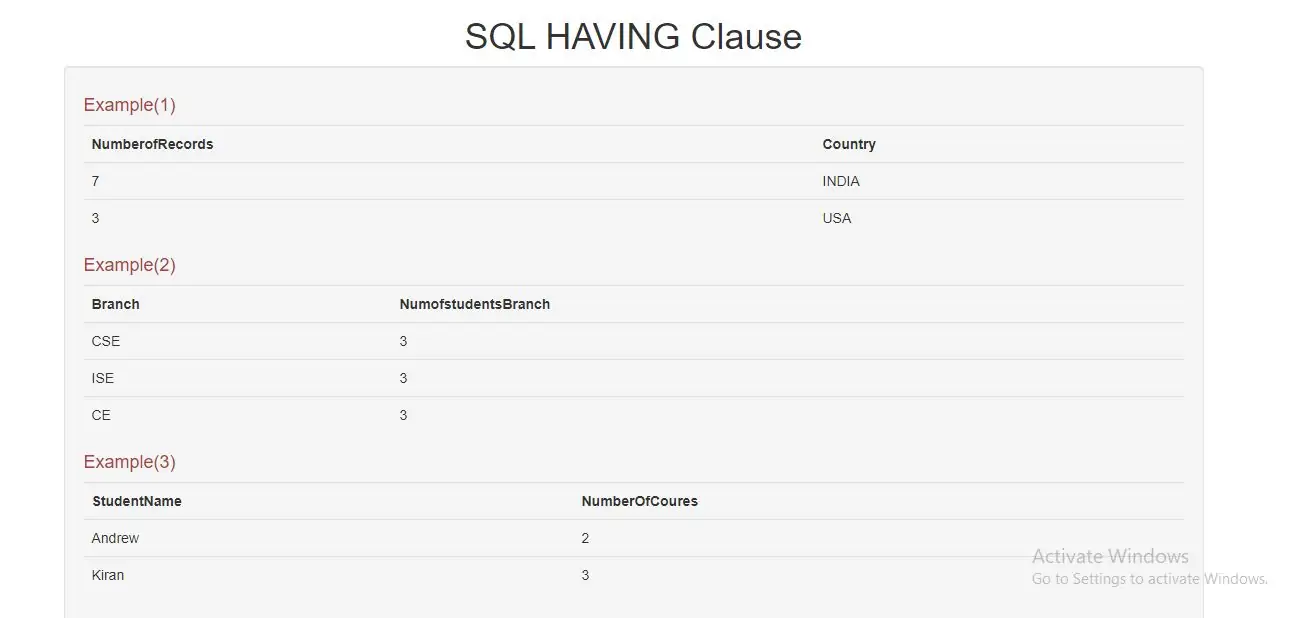
Syntax SQL HAVING Clause
SELECT column_name list
FROM table_name
WHERE condition
GROUP BY column_name list
HAVING condition
ORDER BY column_name list;
Lets Learn.
1.Create database and table.
Student table.
| StudentID | StudentName | Address | Country | Section | Branch | Percentage | CourseID |
|---|---|---|---|---|---|---|---|
| 1 | Liam | 23 Andrew road | USA | A | ISE | 66 | 5 |
| 2 | Andrew | 2415 Anthony market str | Germany | A | ISE | 80 | 6 |
| 4 | Ryan | 18 Christopher sq. | INDIA | B | EE | 67 | 5 |
| 5 | Charles | 878 Eli Berguvsvägen 8 | UK | C | ECE | 52 | 8 |
| 8 | Anikth | 23 Andrew road | AFRICA | A | CSE | 66 | 3 |
| 9 | Andrew | 2415 Anthony market str | Germany | A | ISE | 80 | 2 |
| 10 | Bhavya | 18 Christopher sq. | INDIA | B | CE | 67 | 2 |
| 11 | Charles | 878 Eli Berguvsvägen 8 | INDIA | CL | CE | 52 | 2 |
| 12 | Andrew | 878 Eli Berguvsvägen 8 | INDIA | C | CL | 52 | 3 |
| 13 | Daniel | 878 Eli Berguvsvägen 8 | USA | ME | CSE | 52 | 5 |
| 14 | Jackson | 878 Eli Berguvsvägen 8 | USA | E | CSE | 52 | 5 |
| 15 | Kiran | 878 Eli Berguvsvägen 8 | INDIA | C | ME | 52 | 3 |
| 16 | Kiran | 878 Eli Berguvsvägen 8 | INDIA | ME | CE | 52 | 3 |
| 17 | Kiran | banglore | INDIA | A | ME | 66 | 3 |
Example(1)
SELECT COUNT(StudentID) AS Numberofstudents, `Country` FROM student GROUP BY `Country` HAVING NumberofRecords > 2
above SQL statement selecting studentid and country from student table to lists the number of student in each country As Numberofstudents and counts the country which more than 2 students by SQL HAVING Clause
Example(2)
SELECT COUNT(StudentID) AS NumofstudentsBranch , `Branch` FROM student GROUP BY `Branch` HAVING COUNT(StudentID) > 2 ORDER BY NumofstudentsBranch DESC;
above SQL statement selecting studentid and branch from student table to lists the number of student in each branch, sorted high to low as NumofstudentsBranch (descending order) by SQL HAVING Clause
Example(3)
SELECT student.StudentName, COUNT(course.CourseID) AS NumberOfCoures FROM (course INNER JOIN student ON course.CourseID = student.CourseID) GROUP BY StudentName HAVING NumberOfCoures > 1
SQL statement statement selecting student name from student table and courseid from course table to lists the student that have appers more than 1 by SQL HAVING Clause
<!DOCTYPE html>
<html lang="en">
<head>
<title>How to use SQL HAVING Clause</title>
<meta charset="utf-8">
<meta name="viewport" content="width=device-width, initial-scale=1">
<link rel="stylesheet" href="https://maxcdn.bootstrapcdn.com/bootstrap/3.4.1/css/bootstrap.min.css">
</head>
<body>
<div class="container">
<div class="text-center">
<h1>SQL HAVING Clause</h1>
</div>
<div class="well">
<?php
$connect = mysqli_connect("localhost", "root", "", "school_management");
if ($connect->connect_error) {
die("Connection failed: " . $connect->connect_error);
}
$sql_1 = "SELECT COUNT(StudentID) AS Numberofstudents , `Country` FROM student GROUP BY `Country` HAVING Numberofstudents > 2";
$sql_2 = "SELECT COUNT(StudentID) AS NumofstudentsBranch , `Branch` FROM student GROUP BY `Branch` HAVING COUNT(StudentID) > 2 ORDER BY NumofstudentsBranch DESC";
$sql_3 = "SELECT student.StudentName, COUNT(course.CourseID) AS NumberOfCoures FROM (course INNER JOIN student ON course.CourseID = student.CourseID)
GROUP BY StudentName HAVING NumberOfCoures > 1";
echo "<h4 class='text-danger'>Example(1)</h4>";
if($result_1 = mysqli_query($connect, $sql_1)){
if(mysqli_num_rows($result_1) > 0){
echo "<table class='table'>
<tr>
<th>NumberofRecords</th>
<th>Country</th>
</tr>
";
while($row = $result_1->fetch_assoc()){
echo "<tr>
<td>".$row['Numberofstudents'] /*student table*/ ."</td>
<td>".$row['Country'] ."</td>
</tr>";
}
echo "</table>";
} else{
echo "No records found.";
}
}
echo "<h4 class='text-danger'>Example(2) </h4>";
if($result_1 = mysqli_query($connect, $sql_2)){
if(mysqli_num_rows($result_1) > 0){
echo "<table class='table'>
<tr>
<th>Branch</th>
<th>NumofstudentsBranch</th>
</tr>
";
while($row = $result_1->fetch_assoc()){
echo "<tr>
<td>".$row['Branch'] /*student table*/ ."</td>
<td>".$row['NumofstudentsBranch'] ."</td>
</tr>";
}
echo "</table>";
} else{
echo "No records found.";
}
}
echo "<h4 class='text-danger'>Example(3)</h4>";
if($result_1 = mysqli_query($connect, $sql_3)){
if(mysqli_num_rows($result_1) > 0){
echo "<table class='table'>
<tr>
<th>StudentName</th>
<th>NumberOfCoures</th>
</tr>
";
while($row = $result_1->fetch_assoc()){
echo "<tr>
<td>".$row['StudentName'] /*student table*/ ."</td>
<td>".$row['NumberOfCoures']."</td>
</tr>";
}
echo "</table>";
} else{
echo "No records found.";
}
}
?>
</div>
<br>
</div>
</body>
</html>